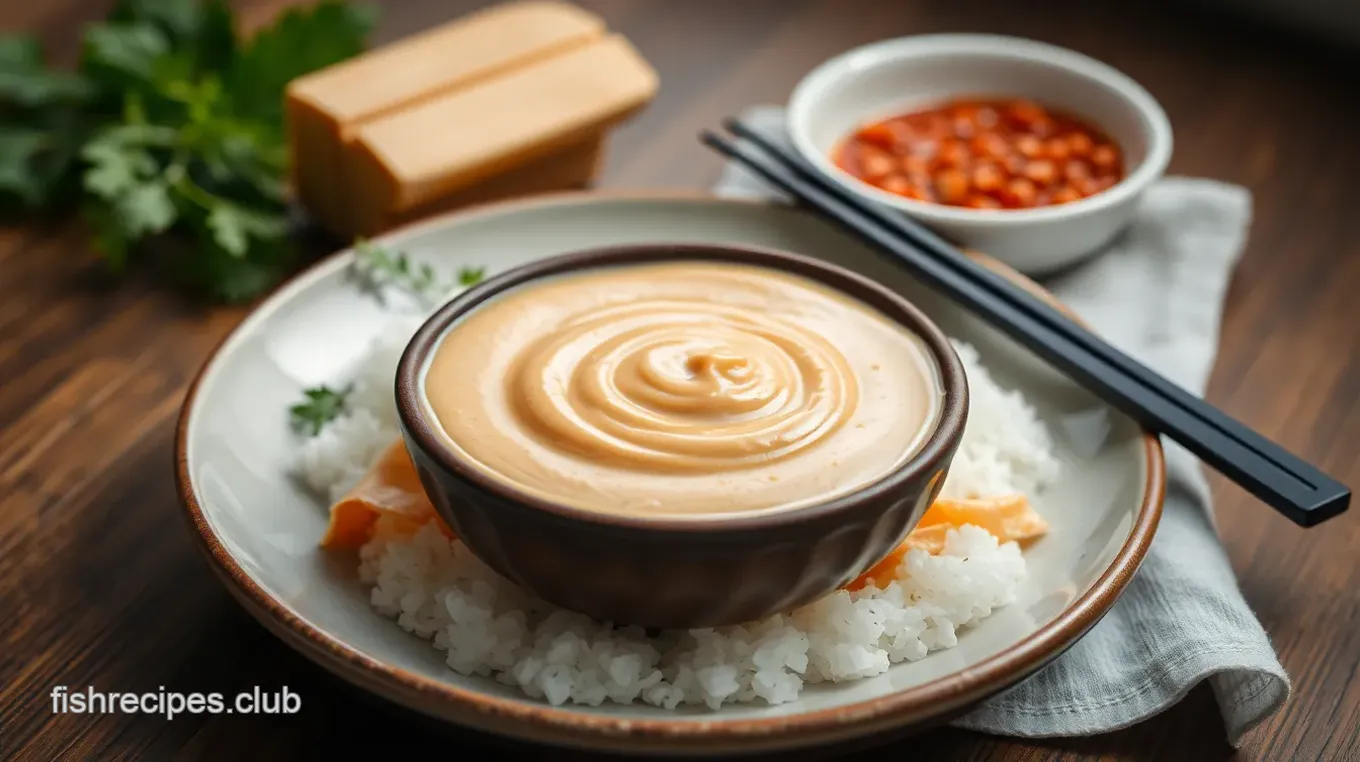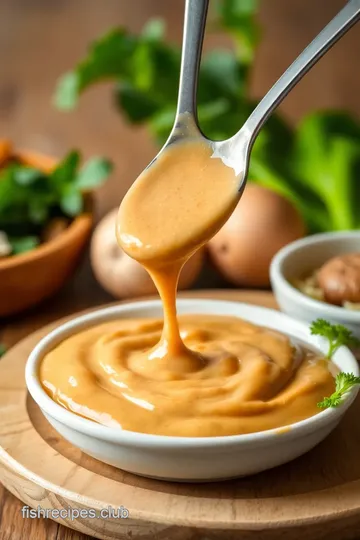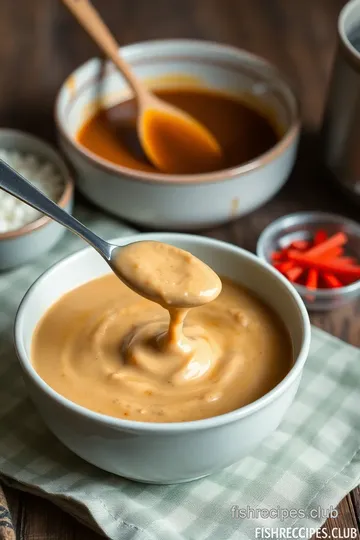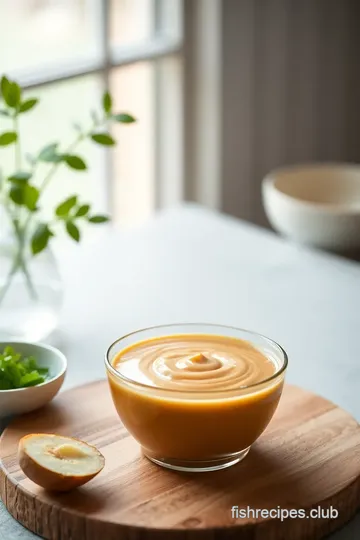Make Satay Sauce: Creamy Peanut Delight
Looking for the best way to make satay sauce? Try my Creamy Peanut Delight for an amazing flavor that transforms grilled meats and veggies into a feast!

- Let’s Get Saucy: The Story Behind My Favorite Satay Sauce
- Recipe Whirlwind: Hailing from Indonesia
- Why Your Taste Buds Need This Sauce
- The Great Transition to Ingredients
- Essential Ingredients Guide
- Professional Cooking Method: Elevating Your Kitchen Game
- Pro Tips & Secrets
- Perfect Presentation
- Storage & Make-Ahead
- Creative Variations
- Complete Nutrition Guide
- Expert FAQ Solutions
- Recipe Card
Let’s Get Saucy: The Story Behind My Favorite Satay Sauce
Oh my gosh, can i tell you a story? picture this: a summer evening, the grill is smokin’, and there’s this amazing aroma wafting through the backyard.
I’m talking about that perfect mix of grilled chicken skewers sizzling away, just begging for a dip in something spectacular.
That’s when i learned how to make satay sauce: creamy peanut delight . honestly, it was a game-changer! from then on, my parties went from “meh” to “wow!” real quick.
Once you try this satay sauce recipe , you’ll get it. it’s like a hug in a bowl, you know? rich and nutty with a twist of zesty lime and a kick of spice—it's perfect for dipping or drenching all your favorite foods.
You’ll be the “sauce wizard” of the backyard in no time, and your friends will keep asking for the secrets to your culinary magic.
Recipe Whirlwind: Hailing from Indonesia
Now, let’s talk about where this deliciousness comes from. the roots of this creamy peanut sauce venture all the way back to indonesia, not to mention it’s been a staple in a lot of asian cuisines ever since.
It’s like the unofficial ambassador of flavors, uniting various cultures around the grill. today, it’s a superstar at barbecues, dinner parties, and potlucks, and guess what? it’s easy to make!
This easy peanut sauce recipe comes together in about 15 minutes flat —that includes prep and cook time! How’s that for a quick gourmet sauce recipe? And I'm telling you, you don’t need to be a master chef; if you can mix stuff together, you’ve got this down!
The best part? you can whip up about 1 cup of this beauty for just a few bucks. perfect for 8 servings! this creamy concoction fits snugly into your budget, and believe me, it’s worth every penny.
Why Your Taste Buds Need This Sauce
Let’s dive into why you’ll love this recipe. first off, there are some serious health benefits of peanuts in play.
Packed with protein and good fats, this sauce isn’t just tasty—it’s good for you too! plus, with the option to make a vegan peanut sauce , it caters to a whole range of diets.
So, whether you’re throwing a bbq or just need an afternoon snack, this sauce fits right in.
And let’s chat about versatility, shall we? this sauce shines on grilled chicken satay but don’t stop there! it makes a bomb peanut sauce dip for fresh veggies, and it goes wonderfully with tofu for my vegan pals out there.
No more boring appetizers—this sauce turns anything into an instant party on a plate!
You can even jazz it up for special occasions! serve it during those summer cookouts or at cozy winter gatherings.
It’s all about bringing those sweet and spicy flavors to the table. trust me, no one will forget those delicious vibes.
The Great Transition to Ingredients
So, are you wondering how to pull off this magic? let’s roll into the ingredients needed to create your own homemade satay sauce .
You’ll be amazed at how simple it is to gather these items. just hang tight; we're almost there!

Essential Ingredients Guide
Alright, friends! let’s dive into the world of flavors with our essential ingredients guide . whether you’re whipping up a classic dish or experimenting with something new, knowing what goes into your kitchen is key.
Today, we’re focusing on the beauty of satay sauce , especially that amazing creamy peanut delight that just makes everything better! trust me, once you learn how to make satay sauce, you’ll be hooked.
Premium Core Components
First things first, let’s break down the premium core components of our peanut sauce recipe.
For starters, you need to know your measurements . Now, I’m talking 1 cup (240ml) of creamy peanut butter to kick things off. For my European friends, that’s about 240 grams.
Next, when selecting your ingredients, keep an eye out for quality indicators . look for natural peanut butter —you want that rich, nutty flavor.
No hydrogenated oils here! for soy sauce, grab some low-sodium if you’re watching your salt.
When it comes to storage, keep your sauce in an airtight container . it’ll hang out in the fridge for about a week.
If you see mold? toss it, no second chances. freshness tips ? always use fresh ginger and garlic for the best taste.
They’ll really amp up your sauce!
Signature Seasoning Blend
Now, let’s talk seasonings. the signature seasoning blend is where the magic happens. you’ll want to combine essential spices like cayenne for a kick.
But don’t worry if spicy isn’t your vibe! adjust that pepper to your taste.
Herbs are where it gets fun. fresh cilantro or basil can switch things up and pair great with grilled chicken satay.
Oh, and a splash of lime really brightens everything up—trust me on this!
Smart Substitutions
Sometimes life throws curveballs—maybe you’re out of soy sauce. no sweat! you can use tamari for a gluten-free option or even coconut aminos if you’re feeling fancy.
If you want a vegan peanut sauce , swap honey for maple syrup. and for a different vibe, almond butter works beautifully too!
If you need a last-minute fix, a little ketchup can stand in for the soy sauce in a pinch. It won’t match the flavor exactly, but it’ll save your lunch!
Kitchen Equipment Essentials
Let’s not forget about the kitchen equipment essentials . You don’t need a fancy food processor to make this creaminess happen. A simple mixing bowl and a whisk will do the trick.
Grab a measuring cup and spoons, and if you’re feeling lazy, a garlic press can save you some chopping time.
Storage? pop that sauce in a jar and label it—nothing worse than a mystery sauce in the fridge, right?
Every tool in the kitchen should feel like your best buddy. tools make the task easier and more fun! if your whisk is serving a better purpose as a decoration than a tool, it's time to invest.
Time to Get Cooking!
So, there you have it—you’re now equipped with an essential ingredients guide to elevate your cooking game. remember, the star of our show is that glorious creamy peanut delight .
It’s not just a sauce; it's a whole experience, best paired with grilled chicken satay or as a tasty peanut sauce dip for your favorite veggies.
Stick around and get ready, because next, i’m going to guide you through the step-by-step instructions of turning these beautiful ingredients into a satay sauce recipe that's totally unforgettable.
Let’s make satay sauce that your friends and family will be raving about for days. bon appétit, my kitchen warriors!
Professional Cooking Method: Elevating Your Kitchen Game
Alright, friends, let’s talk about something we all love—food! cooking can be a blast, but there’s an art to it, especially when we want to whip up something special like make satay sauce: creamy peanut delight .
This creamy peanut dip is not just for your everyday snack; it's a game-changer for grilled chicken skewers, veggie platters, or just about anything you want to dunk! so let’s take a peek at how to do this right, from mise en place to expert techniques.
Essential Preparation Steps
Before you dive in, let's chat about mise en place . this fancy french term just means "everything in its place.
" gather your ingredients: 1 cup (240ml) peanut butter , 1/4 cup (60ml) soy sauce , 3 tablespoons (45ml) lime juice , and other goodies.
Trust me; it makes the process smoother than a creamy peanut sauce!
Next is time management . when you read through the recipe, you'll see it takes about 15 minutes total . oh my gosh, that's super quick! setting a timer helps you stay on track, especially if you’re multitasking.
And don’t forget to get organized . Lay out your measuring cups and spoons. It's like prepping for a dance routine; you need to know your moves before you hit the floor.
Safety comes first! always be cautious with sharp knives when mincing garlic and grating ginger. keep your cooking area tidy, too; we don’t want any sticky messes, especially with a peanut butter sauce recipe .
Step-by-Step Process
Okay, let’s get down to the real deal! Here’s a simple breakdown of how to make that Creamy Peanut Delight :
- Prepare Ingredients: Gather everything. Just grab and go!
- Mix Base Ingredients: In a mixing bowl, combine the peanut butter, soy sauce, lime juice, honey , and sesame oil .
- Add Aromatics: Toss in the ginger and minced garlic . Because who doesn’t love a punch of flavor?
- Incorporate Spices: Add 1/4 teaspoon (1g) of cayenne pepper. Adjust this based on your spice level.
- Whisk Together: Use a whisk or fork and go to town mixing it until it’s all smooth and luscious.
- Adjust Consistency: Gradually add 1/2 cup (120ml) water , one tablespoon at a time to get your desired thickness.
- Taste and Adjust: Seriously, taste it! If it needs more zing, add more lime juice or if it’s not sweet enough, go for a bit more honey .
- Serve or Store: This can go straight to the table or chill in the fridge for a week.
Keep those temperature control points in mind. This isn’t a cooking project where you need to hit a specific temp, but you don’t want it hot enough to melt your face either while tasting!
Expert Techniques
Here’s where we turn up the heat! for a true gourmet sauce recipe , make sure your ingredients are at room temperature before mixing.
It helps everything blend beautifully. during quality checkpoints , taste as you go. might sound simple, but it’s a pro tip!
And if you ever run into a problem—say, the sauce is too thick—just add a little more water. I’ve learned the hard way not to panic. It's cooking, not rocket science!
Success Strategies
So, what about the pitfalls? common mistakes folks make include not tasting as they mix. honestly, this is where some of us go wrong.
It’s all about balancing those sweet and spicy flavors .
Check your quality—the look of your asian dipping sauce should be creamy but not too runny. and hey, if you’re looking to make this ahead, you can store the sauce in an air-tight container in the fridge.
Just give it a good stir before serving, and it will be perfect!
Wrapping It Up
There you have it! with these tips, you’re well on your way to mastering the make satay sauce: creamy peanut delight .
Remember, cooking is as much about enjoying the process as it is about the end result. look into into this recipe, and soon enough, you'll impress your friends and family with this incredible homemade peanut sauce dip .
And for even more kitchen magic, let’s check out the last section: Additional Information. You might just find more cool tips and creative uses for this fantastic sauce there!

Pro Tips & Secrets
Oh my gosh, you guys! Making satay sauce is like unlocking a delicious treasure chest of flavors. Here are some pro tips straight from my kitchen to help you nail it every time!
First off, if you wanna really turn up the flavor, try using natural peanut butter . the kind without all that extra sugar and junk.
It's richer and just tastes... well, more like real peanuts! and don’t forget about the coconut milk ! a splash can take your creamy peanut sauce to a whole new level.
Time-saving hacks? oh, i’ve got a few! we all love a quick kitchen win, right? grab a jar of pre-minced garlic and ginger.
They’re legit lifesavers when you want that freshness without the fuss. seriously, who needs a fancy chef's knife when you can get the same great flavor in seconds?
When it comes to enhancing flavors, taste as you go! a little more lime juice for zing? or a smidge of honey for that sweet spot? you’ll know what’s best as you mix it up.
And for the presentation, my favorite trick is to sprinkle some crushed peanuts and fresh herbs on top. it’s an instant wow factor that makes your dish scream gourmet!
Perfect Presentation
Okay, let's talk about making your satay sauce look as amazing as it tastes. plating techniques can really make a difference, you know? try using a shallow bowl for your sauce.
Not only does it make it easier to dip, but it showcases that creamy texture beautifully.
Garnishes are your best friends! a little sprinkle of chopped scallions or a few cilantro leaves can add that pop of color.
Honestly, it’s like putting a cherry on top of a sundae but for your savory dishes.
Mixing colors is key! pair the soft beige of your peanut sauce with bright yellow bell peppers or colorful carrot sticks.
It's all about creating a plate that makes people go, “wow!” before they even taste it. because, let’s face it, we eat with our eyes first!
Storage & Make-Ahead
So, you’ve made this divine creamy peanut sauce and now you’ve got some leftovers. first of all, lucky you! to store it, pop it in an airtight container in the fridge.
It’ll last about a week, so you can enjoy that rich flavor whenever you want.
If you’re thinking ahead, this sauce is perfect for meal prep! just whip up a batch on sunday and you’ve got a delightful dipping sauce for your grilled chicken satay or veggies all week long.
When it's time to snack, just stir it up and dive in!
When it’s time to reheat, just toss it in the microwave for a few seconds. if it’s a bit thick, add a splash of water to loosen it up.
You want that dippability to come back for sure!
Creative Variations
Okay, let’s get creative! want to jazz it up? try adding some spicy sriracha to your satay sauce for that fiery kick.
Or how about switching things around with some miso paste? think of it as a flavor vacation !
Seasonal twists are fun too. When summer rolls around, toss in some fresh mint. It gives a refreshing spin! For fall, how about a touch of pumpkin puree? Yep, you heard me right!
Don’t forget about dietary needs. If you want to make it a vegan peanut sauce , just swap honey for maple syrup. Gluten-free satay is just a tamari switch away!
Complete Nutrition Guide
So, what's the deal with the nutritional benefits of peanuts? you’re gonna want to know because nuts are packed with protein and healthy fats.
This peanut sauce dip scores high on health benefits . a small serving is around 75 calories, and it's full of good stuff like protein and healthy fats.
Remember, moderation is key, especially with a gourmet sauce recipe like this. stick to about two tablespoons as a serving size.
It’s perfect for adding just the right amount of flavor without going overboard!
Expert FAQ Solutions
Got questions? i’ve been there too! “what if my sauce is too thick?” just add a bit more water. how about “can i use almond butter instead of peanut butter?” totally! it’ll just have a different twist to it.
If your friends are all about low-carb, this creamy sauce for grilling might just make them your best buddies. Everyone loves a good dipping sauce, especially when it’s tasty and easy.
So, there you have it, friends! making satay sauce is super simple, and with these tips, you’ll have everyone at your next bbq raving about your homemade satay sauce recipe .
Don’t underestimate the power of a good sauce. look into in, get creative, and enjoy every creamy, nutty bite. you’ve got this!

Make Satay Sauce: Creamy Peanut Delight Card

⚖️ Ingredients:
- 1 cup (240ml) creamy peanut butter
- 1/4 cup (60ml) soy sauce
- 3 tablespoons (45ml) lime juice (freshly squeezed)
- 2 tablespoons (30ml) honey or brown sugar
- 1 tablespoon (15ml) sesame oil
- 1 tablespoon (15g) grated fresh ginger
- 2 cloves garlic, minced
- 1/4 teaspoon (1g) cayenne pepper (adjust to taste)
- 1/2 cup (120ml) water (adjust for desired consistency)
🥄 Instructions:
- Step 1: Gather all ingredients and equipment.
- Step 2: In a mixing bowl, add the peanut butter, soy sauce, lime juice, honey (or brown sugar), and sesame oil.
- Step 3: Incorporate grated ginger and minced garlic into the mixing bowl.
- Step 4: Sprinkle cayenne pepper into the mixture for heat.
- Step 5: Using a whisk or fork, vigorously combine all ingredients until smooth.
- Step 6: Gradually add water, one tablespoon at a time, whisking until the desired creamy consistency is achieved.
- Step 7: Taste the sauce and adjust flavors as needed – add more lime juice for tang or honey for sweetness.
- Step 8: Serve fresh or store in an airtight container in the refrigerator for up to one week.
Previous Recipe: Ultimate Slow Cooker Chicken with Thai Basil Flavor: A Delicious Comfort Dish!
Next Recipe: My Grandmother's Herb-Crusted Baked Salmon: 30-Minute Delight!
